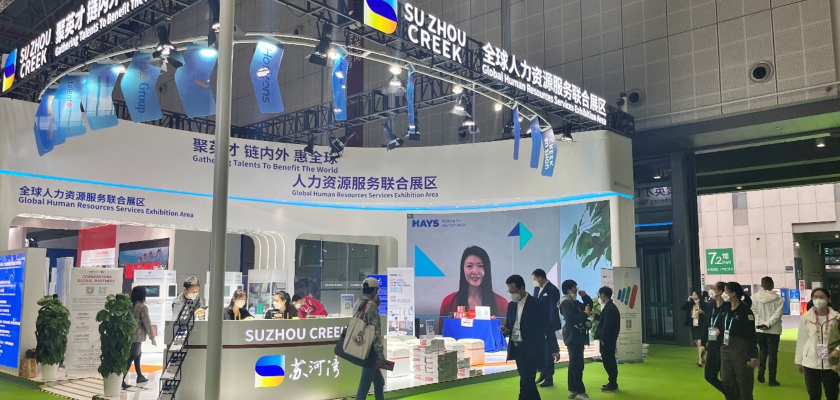China International Import Expo | Hays remains bullish on China’s healthcare industry while new trend rises for demand of core talents

The fifth China International Import Expo (CIIE) opened on November 5, 2022, in Shanghai. Hays, a leading global professional recruiting group was invited to attend CIIE for the first time as exhibitor.
“As one of the highlights of the CIIE this year, the healthcare industry owns the largest exhibition area and the greatest number of exhibitors with nearly 200 related enterprises.
Hays has devoted itself to the healthcare sector for many years and deepened the pool of talent for leading multinational and domestic enterprises, many of which have made their show at CIIE this year,” said Jessica Wang, Managing Director of Hays China. “The impact of COVID-19 triggered increasing demand for talents in life sciences in China. Meanwhile, policy support and investments also make the sector more attractive for talents. Domestic and multinational enterprises are now competing fiercely for core talents,” she added.
Healthcare sector enters a more rational development period, but companies remain optimistic about the Chinese market
The entry of more subdivided multinational enterprises into the Chinese healthcare market has reflected the diversification of domestic demand and the vigorousness of market segmentation. According to CIIE officials, the exhibition area of Medical Equipment & Healthcare Products exhibits drugs, medical devices, elderly rehabilitation and ancillary products, nutritional food, nursing, medical cosmetology, and medical tourism, which covers most sectors and value chain of healthcare sector. The healthcare exhibition zone also exhibited world-leading products and technologies showcasing the trend of digitalization and smartization in the sector. A vivid example of diversification of the market is the Medical Equipment exhibition area, where exhibitors brought in products covering areas including In Vitro Diagnostics (IVD), cardiac therapy, CT imaging, life sciences, genetic testing, kidney, stomatology, and orthopaedics.
The one-stop service trade platform in China International Import Expo has optimized the import registration procedure, thus allowing more high-quality products to make their debut in China as the first show in the world, according to Qiu Peng, the General Manager of Insightec China, an Israel-based medical technology company. He also expressed that the customization and segmentation of the Chinese market would generate more development opportunities for multinational medical enterprises that strenuously cultivate the Chinese market.
In recent years, investors kept enthusiasm towards the healthcare sector and poured substantial amount of investment. On one hand, it has brought unprecedented development opportunities for the whole industry, but on the other, it has made the healthcare market overheated.
Take the R&D of new drugs as an example, China’s new drug sector received RMB 200 billion of investment in 2021, reflecting a significant boom of the sector. However, in 2022 the pace of investment and financing gradually slowed down across the healthcare sector.
“To develop a first-in-class medicine requires patience and appropriate understanding in R&D from the authorities, pharmaceutical companies, research institutes, and investors,” says Dr Ding Sheng, the Founding Dean of the School of Pharmaceutical Sciences, Tsinghua University, and the Institute Director of Global Health Drug Discovery Institute (GHDDI). “Drug discovery and development takes 10 years of time and can cost up to one billion dollars, if considering all the successful and failed trials as well as opportunity cost. However, the success rate is only 10 percent”, he explained.
Previous reports have pointed out that on the primary and secondary markets, pharmaceutical industry is volatile due to macro and micro condition changes. China’s centralised drug procurement policy and health insurance cost control system may bring impact to some enterprises and cause drop in corporate valuation and revenue, leading to their more cautious attitude in the investment expansion strategy compared with that in 2021.
Jessica Wang pointed out that, amid policy changes and the fluctuation of market investment, some healthcare enterprises have adjusted their strategy by tightening their budget on recruitment in 2022 rather than continuing the active team expanding plan in 2021.
However, there is a positive sign despite the negative impact of COVID-19. Both the CDMO and IVD industries are still expanding this year because of relatively abundant capital flow.
“The segmented industries that took the most direct hit from the epidemic include biotechnology and pharmaceuticals. However, quite a few subsectors still show a robust development momentum in 2022 with a huge demand for recruitment,” Jessica Wang said.
In 2022, subsectors including CDMO, IVD, Cell and Gene Therapy (CGT), AI drug development, nucleic acid drugs, medical endoscopes, medical imaging, medical cosmetology, ophthalmology, and dentistry, still have a strong development momentum.
“In general, both investment and development strategies of healthcare enterprises become more rational recently. The growth points in the healthcare industry are now more diverse,” according to Jessica Wang.
Steady progress in subsectors, innovation now drives the demand for talents
The watershed in the pharmaceutical industry in China has appeared since China launched a new round of drug regulatory system reform in 2015, which has greatly stimulated the development of innovative drugs. Besides, the number of R&D projects and applications for clinical trials have increased, while the target selection, technical path, and drug form are more diverse. According to the data from the research report released by China Merchants Bank, a total of forty-four domestic innovative drugs passed China’s NMPA procedure in 2021, a year-on-year increase of 175%. The total number of domestic innovative drugs approved in the year exceeded the sum of the past five years.
Macro policy-wise, the recent 20th CPC National Congress Report reveals that China will accelerate the implementation of innovation-driven development strategy, strengthen the deepened integration of industry-education-research led by enterprises, emphasize goal-oriented practices, and improve the capability of commercialization and industrialization of scientific and technological breakthroughs. At the same time, the Report also calls upon the goal of building China as a key talent centre and innovation leader globally, while promoting a more balanced distribution of talents to form advantages in international competition for talents. Such direction brings positivity for the future of China’s healthcare industry.
In comparison with the more “traditional” practices of pharmaceutical industry, new tracks such as gene therapy, AI Drug Development, and nucleic acid drugs are empowering the development of the industry and creating a huge demand for talents. “Under the current need for innovation, core talents in the early stages of drug R&D, such as fundamental research and clinical development, are scarce in China, which leads to companies’ dependent on bringing in overseas top talents. By far, the salary level for those experts in China is equal to that of the United States, and there may even be a salary increase of 10%-15% for some core positions,” Jessica Wang said.
To cope with the shortage of talents in the sector of innovation drugs, Dr Ding Sheng again emphasized on patience. “Although the R&D talents trained in China are now world-class, industry talents with practical experience are very rare. We need to first acknowledge that innovation drug still undergoes a new development stage in China, so the market needs more patience in cultivating core talents in need,” he said.
For medical devices, localization is now a keyword. Quite a few enterprises gradually ramp up their investment, expand local cooperations, and step up the pace of conducting R&D and building manufacturing sites in China.
Qiu Peng introduced that multinational medical equipment enterprises are accelerating the localization process. “Foreign companies are continuously optimizing the recruitment plan and training path for local talents, while expanding business partnerships and promoting cooperation in clinical trials in China.”
Local companies and multinational companies in healthcare sector apply different human resources strategies, and it will need candidates to be prepared for the changes to come.
According to Hays, the recruitment trend in the healthcare industry is generally stable at the present stage. The multinational enterprises in the industry have a huge demand for talents with abundant knowledge of medicine, market strategy, market access, and product promotion, while domestic companies are actively looking for researchers and scientists in the early-stage research and clinical trials.
In terms of medical devices, multinational enterprises need skilled talents in strategic planning and channel optimization, while the domestic firms focus on the recruitment of people with a good command of R&D. Talents with different industry backgrounds gain popularity.
Jessica Wang explained that “the fundamental technology applied to the product line of medical devices mainly refers to technology in electronics, software, and materials. The shortage of talents is now pushing medical device enterprises to locate and recruit candidates with compound skilled background, ranging from industrial automation, manufacturing, electronic engineering, and mechanical engineering.”
In the process of hiring, Jessica Wang suggests that “employers need to formulate more detailed talent strategies, such as making clearer career development plans, customizing positions for overseas talents, and providing experts with more opportunities to adjust their positions flexibly to attract and retain talents.”
“On top of sound salary and benefit package, to attract talents, we also pay great attention to candidates’ matching degree with the position and their need for company culture, work flexibility, and personal development. A good offer must show authentic care for the health and happiness of employees. Only in this way can an enterprise attract like-minded talents to join in and work together for the company’s target,” said Sheng Wei, COO of Shanghai Shenqi Medical Technology.
“Hays remains bullish the long-term development of China’s healthcare industry,” Jessica said. “When occasional fluctuations of the market happen, we recommend job seekers to manage expectations, seek a balance between risks and opportunities, and stay clam during salary fluctuations.”
-end-
About Hays
Hays plc (the "Group") is the world’s leading specialist in workforce solutions and recruitment, such as RPO and MSP. The Group is the expert at recruiting qualified, professional and skilled people worldwide, being the market leader in the UK, Germany and Australia and one of the market leaders in Continental Europe, Latin America and Asia. The Group operates across the private and public sectors, dealing in permanent positions, contract roles and temporary assignments. As at 30 June 2022, the Group employed c.13,000 staff operating from 253 offices in 32 countries. For the year ended 30 June 2022:
– the Group reported net fees of £1,189.4 million and operating profit of £210.1 million;
– the Group placed around 83,750 candidates into permanent jobs and around 250,000 people into temporary roles;
– 16% of Group net fees were generated in Australia & New Zealand, 26% in Germany, 22% in United Kingdom & Ireland and 36% in Rest of World (RoW);
– the temporary placement business represented 55% of net fees and the permanent placement business represented 45% of net fees;
– Technology is the Group’s largest specialism, with 26% of net fees, while Accountancy & Finance (14%) and Construction & Property (11%), are the next largest
– Hays operates in the following countries: Australia, Austria, Belgium, Brazil, Canada, Chile, China, Colombia, the Czech Republic, Denmark, France, Germany, Hungary, India, Ireland, Italy, Japan, Luxembourg, Malaysia, Mexico, the Netherlands, New Zealand, Poland, Portugal, Romania, Singapore, Spain, Sweden, Switzerland, UAE, the UK and the USA
– the Group placed around 83,750 candidates into permanent jobs and around 250,000 people into temporary roles;
– 16% of Group net fees were generated in Australia & New Zealand, 26% in Germany, 22% in United Kingdom & Ireland and 36% in Rest of World (RoW);
– the temporary placement business represented 55% of net fees and the permanent placement business represented 45% of net fees;
– Technology is the Group’s largest specialism, with 26% of net fees, while Accountancy & Finance (14%) and Construction & Property (11%), are the next largest
– Hays operates in the following countries: Australia, Austria, Belgium, Brazil, Canada, Chile, China, Colombia, the Czech Republic, Denmark, France, Germany, Hungary, India, Ireland, Italy, Japan, Luxembourg, Malaysia, Mexico, the Netherlands, New Zealand, Poland, Portugal, Romania, Singapore, Spain, Sweden, Switzerland, UAE, the UK and the USA






